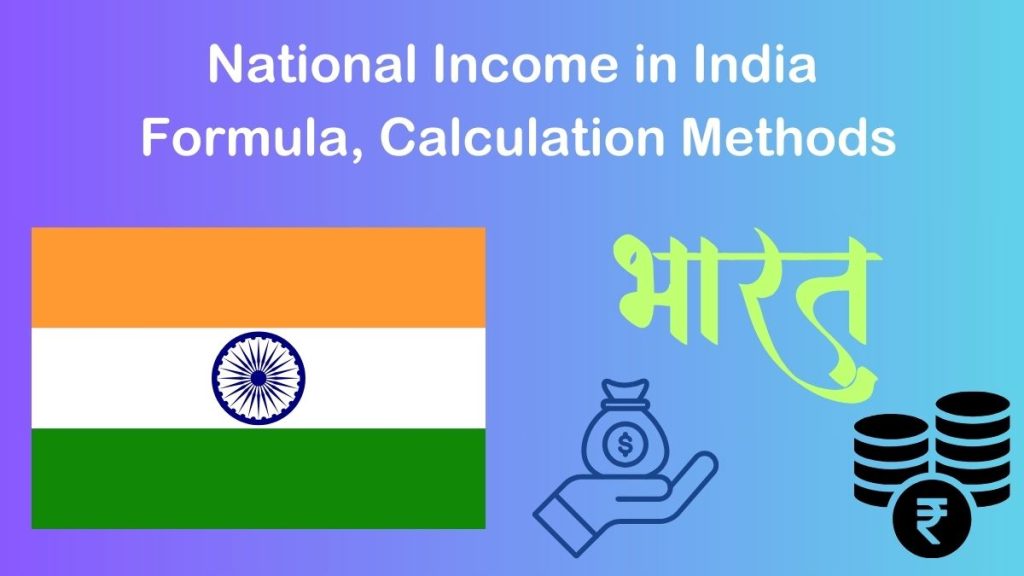National income is one of the major concepts of economics that measures the money value of all the goods and services produced in the country during a given period. Understanding national income is, therefore, crucial for India, since it indicates the overall health of the country’s economy, development, and progress. Using particular formulas and ways of calculation, economists can obtain the total income generated within the nation, providing insights into growth patterns and resource allocation. This blog is the Indian formula for calculating national income, several methods of calculating it and their importance in simple words to make things clear to the students and readers.
Understanding the India formula for calculating national income will evaluate the country’s overall economic performance. Calculation analysis of the levels of production, income distribution, and consumption will enlighten developmental gaps and growth opportunities in calculation. The right assessment of national income will help policymakers in taking correct decisions for balanced and sustainable economic growth.

What is National Income?
National income is the summation value of all final goods and services produced by a nation in a financial year. It provides some view of the performance of the economy and will assist policymakers in formulating proper strategies toward growth. In India, it also consists of certain formulas and ways through which total income received by individuals, businesses, and the government are derived to draw the idea of health and development in the nation.
Importance of National Income
- National income could simply be taken as the reflection of health in a country. National income rising would be growth, while decreasing would indicate problems in the economy.
- policies It also enables the government to formulate its economic policies such as tax reforms, employment programs, and social welfare schemes.
- Standard of Living: This measures the average income for the citizen, thereby helping determine the standard of living in the country.
- Sectoral Insights It gives details about the contribution of different sectors, such as agriculture and industry toward services within the economy.
Formula for Calculating the National Income of India
It refers to how it generally calculated: all total amounts of goods and services produce, income from wages and rents, interests, profits. This is the basis whereby every indication becomes clear in terms of their performance, hence enabling all this to be judged about total National Income and its contribution in economic growth.
National Income = NDP (Net Domestic Product) + NFIA (Net Factor Income from Abroad)
Where:
- NDP stands for Net Domestic Product, which is given as Gross Domestic Product minus depreciation.
- NFIA is the difference between income earned by Indian residents from abroad and income earned by foreign residents in India.
Methods of Calculating National Income
In India, national income is estimated by using three major methods, namely the India formula for calculating the income method, the expenditure method, and the production method. The above-mentioned approaches will accurately estimate the total income of the country, providing a broad perspective of national income and its role in India’s economic development and planning:
- Value Added Method/Production Method
- Income Method
- Expenditure method
But different techniques, different perceptions bring in the same amount when done the right way. Let’s focus on those techniques in an elaborated manner.
1. Value Added Method-Production Method
This method emphasizes the value added at each stage of production in the economy. It measures the total value of goods and services produced in the country, excluding intermediate goods to avoid double counting.
Formula:
National Income = Gross Value of Output – Value of Intermediate Consumption
Steps in Production Method:
- Gross output of all the sectors of production namely: Agriculture, industry, and services.
- Deduct the cost of intermediate goods and services.
- Sum up the net values for all sectors.
Example Table:
| Industry | Gross Output (₹) | Intermediate Consumption (₹) | Net Value Added (₹) |
| Agriculture | 20,00,000 | 5,00,000 | 15,00,000 |
Industry | 30,00,000 | 10,00,000 | 20,00,000 |
| Services | 25,00,000 | 5,00,000 | 20,00,000 |
| Total | 55,00,000 |
2. Income Method
The income method calculates national income by summing up all the incomes generated by factors of production in a country, such as land, labor, capital, and entrepreneurship.
Formula:
National Income = Remuneration of Employees + Surplus Operating + Mixed Income Self-employed + Net Factor Income from Abroad
Parts:
- Compensation of Employees: Salaries, wages, and other benefits.
- Operating Surplus: Profits earned by businesses.
- Mixed Income: Income earned by self-employed persons, such as small business owners, freelancers, etc.
Example Table:
| Income Component | Value (₹) |
| Compensation of Employees | 30,00,000 |
| Operating Surplus | 20,00,000 |
| Mixed Income of Self-employed | 10,00,000 |
| Net factor income from abroad | 5,00,000 |
| Total National Income | 65,00,000 |
3. Cost Method
This method calculates the nation’s income based on summation of all expenditures incurred by an economy. The kinds of expenditure include consumption, investment, government spending, and net export.
Formula:
National Income = C + I + G + (X – M)
Where:
- C: Consumption expenditure by the household.
- I: Investment by business.
- G: Government spending.
- X – M: Net exports (exports minus imports).
Example Table:
| Expenditure Element | Value (₹) |
| Consumption (C) | 40,00,000 |
| Investment (I) | 15,00,000 |
| Government Spending (G) | 20,00,000 |
| Net Exports (X – M) | 5,00,000 |
| Total National Income | 80,00,000 |
Challenges in Calculating National Income in India
- Informal Sector: The unorganized sector forms a huge portion of India’s economy. Data collection becomes challenging here.
- Data Accuracy: It may be wrong based on old or incomplete data.
- Regional Disparities: Economic activities vary significantly across states, making standardization challenging.
- Non-Monetary Transactions: Barter trade or home production cannot easily be included in national income.
Uses of National Income Data
- Economic Planning: It helps in preparing 5-year plans and annual budgets. International
- Comparisons: It allows comparison with other countries to understand India’s global standing.
- Business and investors rely on the information of national income to evaluate market potential.
- Poverty Analysis: Enables income distribution and the living standard to be estimated.
Key Terms to Remember
| Term | Definition |
| Gross Domestic Product (GDP) | The total value of goods and services produced within the country’s borders. |
| NDP (Net Domestic Product) | GDP minus depreciation. |
| GNP (Gross National Product) | GDP plus net income from abroad. |
| NNP (Net National Product) | GNP less depreciation. |
Key Indicators Related to National Income
National income is highly related with a number of indicators that tend to increase the depth in understanding the economy. Such indicators including GDP, GNP, and per capita income complement the analysis of national income on the basis of India formula and proper method of calculation thereof, thereby offering an all-inclusive view of national economic progress and performance.
Per capita income
- Formula: Per Capita Income = National Income ÷ Population
- It calculates the average income earned by a country’s residents and portrays its standard of living.
- Regional disparities still persist in India as its per capita income has grown over the years.
Growth Rate of National Income:
- It tracks the change in national income over time.
- A higher growth rate would mean greater economic progress, while a low one would signal stagnation or decline.
Savings and investments.
- National income reflects on the savings rate of a nation, which in turn affects investment in infrastructure, education, and healthcare.
Income Distribution:
- Though national income gauges the size of the economy, it does not reveal the even distribution of the income among the citizens.
Sectors Contributing to National Income in India
The three big sectors contributing to the generation of India’s national income can be considered. Calculating income creation by the use of the India formula, contribution of all sectors is determined toward the aggregation of national income to examine growth prospects and sectoral performance and proper resource distribution in a country.
Agriculture Sector:
- This constitutes the highest percentage and largely in rural India.
- Agriculture, forestry, fishery, and livestock are included.
Industry Sector
- Manufacturing, mining, construction, and electricity generating.
- It plays a key role in job creation and development infrastructure.
Service Industry
- The largest contributor to the country’s national income.
- Covers IT services, banking, education, health services, and tourism.
National Income and Sustainable Development
National income alone can’t capture the quality of economic growth. The India formula and calculation of income throw light on economic performance but sustainable development focuses on growth supporting the environment and future generations. This balanced approach ensures that the growth of national income does not conflict with long-term ecological and social well-being.
- Green GDP: It incorporates environmental degradation into traditional GDP.
- Some of the social indicators that make sure inclusive growth are education, health, and gender equality.
By integrating sustainability into national income calculations, India can promote long-term prosperity.
Comparison of National Income with Global Economies
India is the world’s fifth-largest economy (2024) based on nominal GDP. Still, adjusted for purchasing power parity, India ranks third. National income is based on the India formula to calculate; it represents the economic position of the country, whereas PPP gives a more accurate representation of the real income and purchasing power.
Table: National Income Comparison with Other Economies
| Country | Nominal GDP (in Trillion USD) | GDP per Capita (USD) |
| United States | 26.9 | 80,000 |
| China | 19.4 | 13,000 |
| India | 3.7 | 2,500 |
| Japan | 4.9 | 39,000 |
India’s lower per capita income indicates that while the economy is large, income distribution needs improvement.
Challenges in Measuring National Income
Measuring national income in India poses challenges due to informal sectors, unrecorded transactions, and regional disparities. The India formula for calculation of income may miss these factors, leading to inaccurate estimations. Additionally, variations in data collection methods and inflation adjustments complicate precise measurement of true national income.
- Informal economy
As it functions on an informal economy majority of its economic activities India, therefore, cannot gather data correctly.
- Unrecorded Transactions:
Non-monetary exchange may include barter, production at home, and home manufactures.
- Population Growth:
Rapid population growth impacts per capita income as it dilutes the advantages of rising national income.
- Underreporting of Income:
Income data will also contain discrepancies arising from tax evasion and underreporting by businesses.
Policies and Reforms to Improve National Income
Policies are well defined that boost productivity and growth across sectors for the increase in national income in India. The efforts put into the enhancement of generating income in agriculture, industry, and services are calculated using the India formula. It plays a significant role in improving the overall national income and economic development:
- Make in India
Stimulates both local and external investment in production.
- Digital India:
Digitises the economy to become an easy, efficient, and clean nation.
- MSME Development
It supports small and medium enterprises, which are major contributors to employment and income.
- Agricultural Reforms:
Schemes like PM-KISAN and investment in rural infrastructure are aimed at enhancing agricultural productivity.
Interesting Facts About National Income in India
- India adopts 2011–12 as its base year to calculate its GNP and national income.
- Service sector accounts for more than 50% of GDP in India; therefore, it is the biggest sector.
- In 2015, India switched to using the market price method of computation of its GDP as compared to the factor cost method.
- The NSO publishes national income data quarterly and yearly.
How can the students understand national income better?
- Start with the Basics: Know what GDP, GNP, NNP, and NDP are.
- Practice Calculations: Compute the following numerical problems on income, production, and expenditure methods.
- Follow the news on policy directions, reforms, and the presentation of budgets that impact this income.
- Use Online Resources: ixamBee, NCERT materials, and RBI reports are good for detailed learning.
Conclusion
National income is one of the key economic indicators of the nation that gives an overall idea about India’s economic performance. If calculated in different ways—such as production, income, or expenditure—the result helps gain valuable insight into the economy’s structure and function. Policy makers, business organizations, and people rely on the data. It helped me understand this idea of national income-a student and a reader -how an economy actually operates. With such a vibrant and diverse economy, the calculation of national income and its detailed analysis would take India to brighter and more prosperous futures.
Prepare for the SEBI Grade A Exam with ixamBee’s comprehensive resources! Boost your chances of success with expert-designed SEBI Grade A Phase 1 mock tests, detailed online courses, and SEBI Grade A Officer Phase 1 PYP. Our targeted banking online course will provide you with in-depth knowledge and strategies, ensuring you are fully prepared for every stage of the SEBI Grade A Exam.
ixamBee specializes in providing expert guidance and resources for banking exams 2024, ensuring that you are well-prepared for the Upcoming Bank Exams like RBI Grade B, NABARD Grade B, IBPS SO, and more. Our courses align with the bank exam calendar 2024, covering all the essential topics. With a focus on the upcoming bank jobs, our Previous Year Papers, BeePedia, SSC CGL, SSC CHSL, SSC MTS and other Mock Tests are designed to help you excel in upcoming banking exams.
Also read:
List of Top 10 Army in the World
List of Bank Holidays 2025 in India
Republic Day: Celebrating the Spirit of India















